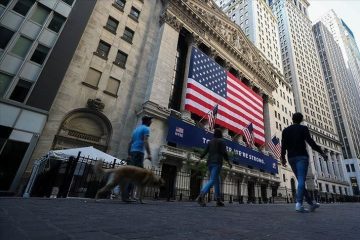Strong growth data obscure a probable slowdown to come

FINANCIAL MARKETS may have wobbled in recent weeks—the S&P 500 fell by 7.3% in October. But America’s real economy still seems to be in rude health. Figures released on October 26th showed economic growth of 3.5%, at an annualised rate, in the third quarter of 2018. Most economists had expected a sharper slowdown after the 4.2% expansion recorded in the preceding three months. On just one other occasion since the financial crisis, in 2014, has America clocked up two consecutive quarters of such speedy growth. Can it last?
Some fear not. The economy has been given temporary fizz by President Donald Trump’s tax cuts. Though these will be in place for some time, the impact on growth may not last. Together with February’s budget bill, they will boost annual GDP growth by 0.6-0.8 percentage points by the end of 2018. But the impact will fade to 0.3 percentage points in 2019 at best, estimate Karen Dynan and Jason Furman of the Peterson Institute for International Economics, a think-tank. Most forecasters expect America to return soon to a growth rate close to 2%, with the main legacy of the tax cuts being weaker public finances.
Boosters retort that the tax cuts will unleash permanently higher growth and investment. Although an ageing population is a drag, a hot economy could enable productivity to grow faster. That would provide the recovery’s final missing ingredient and support growth even as the immediate effect of fiscal stimulus wears off.
At first glance the growth data do little to settle this debate. Over the first half of 2018 taxes on personal income were lower as a share of GDP, compared with the same period in 2017, by around 0.4 percentage points, and those on corporate income by around 0.7 percentage points. In the third quarter government taxation and spending contributed around 0.7 percentage points of the overall 3.5% growth rate, according to estimates by the Brookings Institution, a think-tank (see chart). Though this is the government’s biggest contribution to real GDP growth since 2010, the economy would probably still be enjoying an uptick in growth without it.
Yet a closer inspection offers more support for a pessimistic view. Consider two components of growth: investment and trade. Non-residential investment was disappointingly weak in the third quarter, particularly given the economy’s broader strength. Just 12% of 116 businesses recently surveyed by the National Association of Business Economics reported that they had increased their investments in response to the tax cut. Investments take time to plan and the data are noisy. But Mr Trump’s tax cut was supposed to lead to a sustained investment bonanza. There are few signs of that so far.
There may be trouble in the housing market, too. Private investment in housing, including spending on equipment by landlords, fell for the third consecutive quarter. Explanations include demand constrained by affordability, as well as supply constrained by pricier land, a shortage of immigrant labour for construction and tariffs that have driven up costs. Changes in the tax treatment of housing and interest-rate rises may matter, too.
Meanwhile Mr Trump’s tariffs are buffeting trade. A surge in soyabean sales has gone into reverse. Businesses have stocked up on inventory—enough to add more than two percentage points to growth in the third quarter. But this may be because they were preparing for dearer imports after tariffs on Chinese goods came into effect. If so, then those inventories represent spending brought forward rather than genuine growth. Trade worries may be behind the investment slowdown. The latest edition of the Federal Reserve’s Beige Book, which gathers anecdotal evidence on the economy from the private sector, includes repeated mentions of uncertainty about the trade environment.
If investment continues to sag, growth will depend more on consumption, which in turn depends on rising employment, working hours and real wages. “The resiliency of the expansion rests purely with the labour market,” says Julia Coronado of MacroPolicy Perspectives, a consultancy. So far this seems to be holding up. Private-sector wages are growing faster than in a decade; figures due to be released on November 2nd were expected to show another month of strong employment increases, as well as enough wage growth to push the year-on-year change above 3% for the first time since 2009.
Another risk looms as a result: that the Fed might raise interest rates too fast. It is the central bank’s job to respond appropriately to the application and withdrawal of fiscal stimulus. It is not expected to raise interest rates at its next meeting, which ends on November 8th. But investors do expect another rate rise in December, and three more in 2019. As markets have swooned, these expectations have barely shifted. That might change if data on the real economy took a sharp turn for the worse. (Higher rates may be another explanation for the investment slowdown.)
The pessimists are surely right that, even if there is scope for productivity to grow faster, growth will slow as fiscal stimulus fades. And it is easier for the Fed to manage a downturn that it knows is coming than one that comes out of the blue. Still, excessive monetary tightening often precedes recessions. Growth may look good for now. But policymakers need to be ready to turn on a dime.
This article appeared in the Finance and economics section of the print edition under the headline “What goes up”


